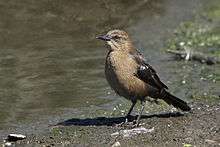Brewer's blackbird
| Brewer's blackbird | |
|---|---|
 | |
| male | |
 | |
| female | |
| Scientific classification | |
| Kingdom: | Animalia |
| Phylum: | Chordata |
| Class: | Aves |
| Order: | Passeriformes |
| Family: | Icteridae |
| Genus: | Euphagus |
| Species: | E. cyanocephalus |
| Binomial name | |
| Euphagus cyanocephalus (Wagler, 1829) | |
 | |
| Range of E. cyanocephalus Breeding range Year-round range Wintering range | |
| Synonyms | |
|
Euphagus affinis (Shufeldt, 1892) | |
The Brewer's blackbird (Euphagus cyanocephalus) is a medium-sized New World blackbird. It is named after the ornithologist Thomas Mayo Brewer.
Description
Adult males have black plumage with an iridescent purple head and neck and glossy bluish-green highlights on the rest of the body. The feet and legs are black and the eye is bright yellow. The female is brownish-grey with slight hints of the male's iridescence. The female's eye is dark brown. Overall, they resemble the eastern member of the same genus, the rusty blackbird; however, the Brewer's blackbird has a shorter bill and the male's head is iridescent purple.[2] This bird is often mistaken for the common grackle but has a shorter tail. The call is a sharp check which is also distinguishable. This bird is in a different family from the Eurasian blackbird.
| Standard Measurements[3][4] | |
|---|---|
| length | 8–10.3 in (200–260 mm) |
| weight | 63 g (2.2 oz) |
| wingspan | 15.5 in (390 mm) |
| wing | 121–133 mm (4.8–5.2 in) |
| tail | 95–102.5 mm (3.74–4.04 in) |
| culmen | 20.4–24 mm (0.80–0.94 in) |
| tarsus | 29.5–33.5 mm (1.16–1.32 in) |
Habitat
Their breeding habitat is open and semi-open areas, often near water, across central and western North America. The cup nest can be located in various locations: in a tree, in tall grass or on a cliff. They often nest in colonies.
These birds are often permanent residents in the west. Other birds migrate to the southeastern United States and Mexico. The range of this bird has been expanding east in the Great Lakes region.[5]
Feeding
They forage in shallow water or in fields, mainly eating seeds and insects, some berries. They sometimes catch insects in flight. They feed in flocks outside of the breeding season, sometimes with other blackbirds.
Protected Status
The Brewer's blackbird (Euphagus cyanocephalus) is protected under the Migratory Bird Treaty Act of 1918.[6]
Gallery
- E. cyanocephalus male.
 E. cyanocephalus female.
E. cyanocephalus female. The iridescent purple head of the male is a distinguishing feature.
The iridescent purple head of the male is a distinguishing feature. Male, Nevada, US
Male, Nevada, US.jpg) Male, Oregon, US
Male, Oregon, US
References
- ↑ BirdLife International (2012). "Euphagus cyanocephalus". IUCN Red List of Threatened Species. Version 2013.2. International Union for Conservation of Nature. Retrieved 26 November 2013.
- ↑ Peterson, Roger Tory; Peterson, Virginia Marie (2002). Birds of Eastern and Central North America (5th ed.). New York, NY: Houghton Mifflin. p. 310. ISBN 0-395-74047-9.
- ↑ Godfrey, W. Earl (1966). The Birds of Canada. Ottawa: National Museum of Canada. p. 359.
- ↑ Sibley, David Allen (2000). The Sibley Guide to Birds. New York: Knopf. p. 514. ISBN 0-679-45122-6.
- ↑ Stepney, P.H.R.; Power, Dennis M. (December 1973). "Analysis of the Eastward Breeding Expansion of Brewer's Blackbird Plus General Aspects of Avian Expansions" (PDF). The Wilson Bulletin. 85 (4): 452–464.
- ↑ "List of Migratory Bird Species Protected by the Migratory Bird Treaty Act as of December 2, 2013". US Fish & Wildlife Service.
Further reading
- Martin, Stephen G. (2002). Poole, A.; Gill, F., eds. "Brewer’s Blackbird (Euphagus cyanocephalus)". The Birds of North America Online. Philadelphia, PA: The Birds of North America, Inc. (Subscription required (help)).
External links
| Wikimedia Commons has media related to Euphagus cyanocephalus. |
| Wikispecies has information related to: Euphagus cyanocephalus |
- Brewer's Blackbird Species Account – Cornell Lab of Ornithology
- Brewer's Blackbird – Euphagus cyanocephalus – USGS Patuxent Bird Identification InfoCenter
- BirdLife species factsheet for Euphagus cyanocephalus
- "Brewer's blackbird media". Internet Bird Collection.
- Brewer's blackbird photo gallery at VIREO (Drexel University)
- Audio recordings of Brewer's blackbird on Xeno-canto.
